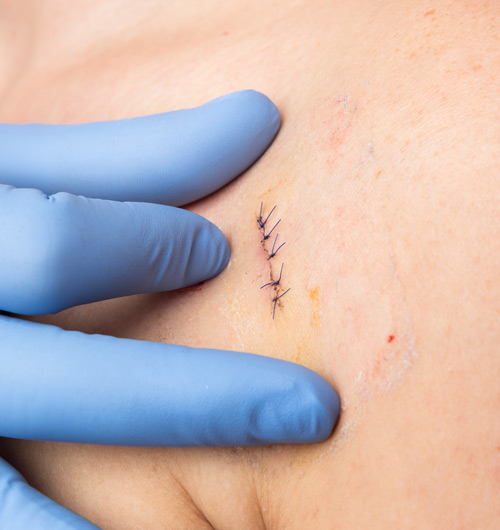Basal Cell
Basal Cell Carcinoma
After the physician’s examination, the diagnosis of basal cell carcinoma is confirmed with a biopsy. Through this procedure, a small piece of tissue is removed and examined in the laboratory under a microscope. If tumor cells are present, treatment, usually surgery, is required.
Fortunately, there are several effective methods for eradicating basal cell carcinoma. The physician’s choice of treatment is based on the type, size, and on the patient’s age and general health.
Treatment can almost always be performed on an outpatient basis, in the physician’s office or at a clinic, with the various surgical techniques, a local anesthetic is used. Pain or discomfort during the procedure is minimal, and there is rarely any pain afterward.

Treatment of Basal Cell Carcinomas in Palm Harbor
Excisional Surgery
The physician removes the entire growth and an additional border of normal skin as a “safety margin.” The surgical site is then closed with stitches and the tissue sent to the laboratory to determine if all the malignant cells have been removed.
Electrosurgery
This method is the most widely used by dermatologists. Cancerous tissue is scraped from the skin with a curette (a sharp ring-shaped instrument). An electric needle then burns a safety margin of normal skin around the tumor and at the base of the area that has been scrapped. This technique is repeated several times to ensure complete removal.
Cryosurgery
Without cutting the growth, tumor tissue is destroyed by freezing with nitrogen. This procedure may be repeated several times to insure the total destruction of malignant cells. Easy to administer, cryosurgery is the treatment of coo no for patients who have bleeding disorders or an intolerance to anesthesia.
Radiation Therapy
X-ray beams are directed at the malignant cells. Total tumor destruction generally requires a series of treatments, usually several times a week for a few weeks. Radiation therapy may be used with elderly patients or with individuals whose overall health is poor.
Mohs Surgery
The physician removes very thin layers of the malignant growth, checking each layer thoroughly through a microscope. The excision is repeated as needed until the site is tumor-free. This method saves the greatest amount of healthy tissue. It is frequently used for tumors that recur and for tumors in difficult locations.
Laser Surgery
The laser beam is used either to excise the tumor or to destroy it by vaporization, in a procedure analogous to electrodesiccation. The major advantage of this relatively new surgical technique is that it sears blood vessels as it cuts, making it useful for patients with bleeding disorders.
